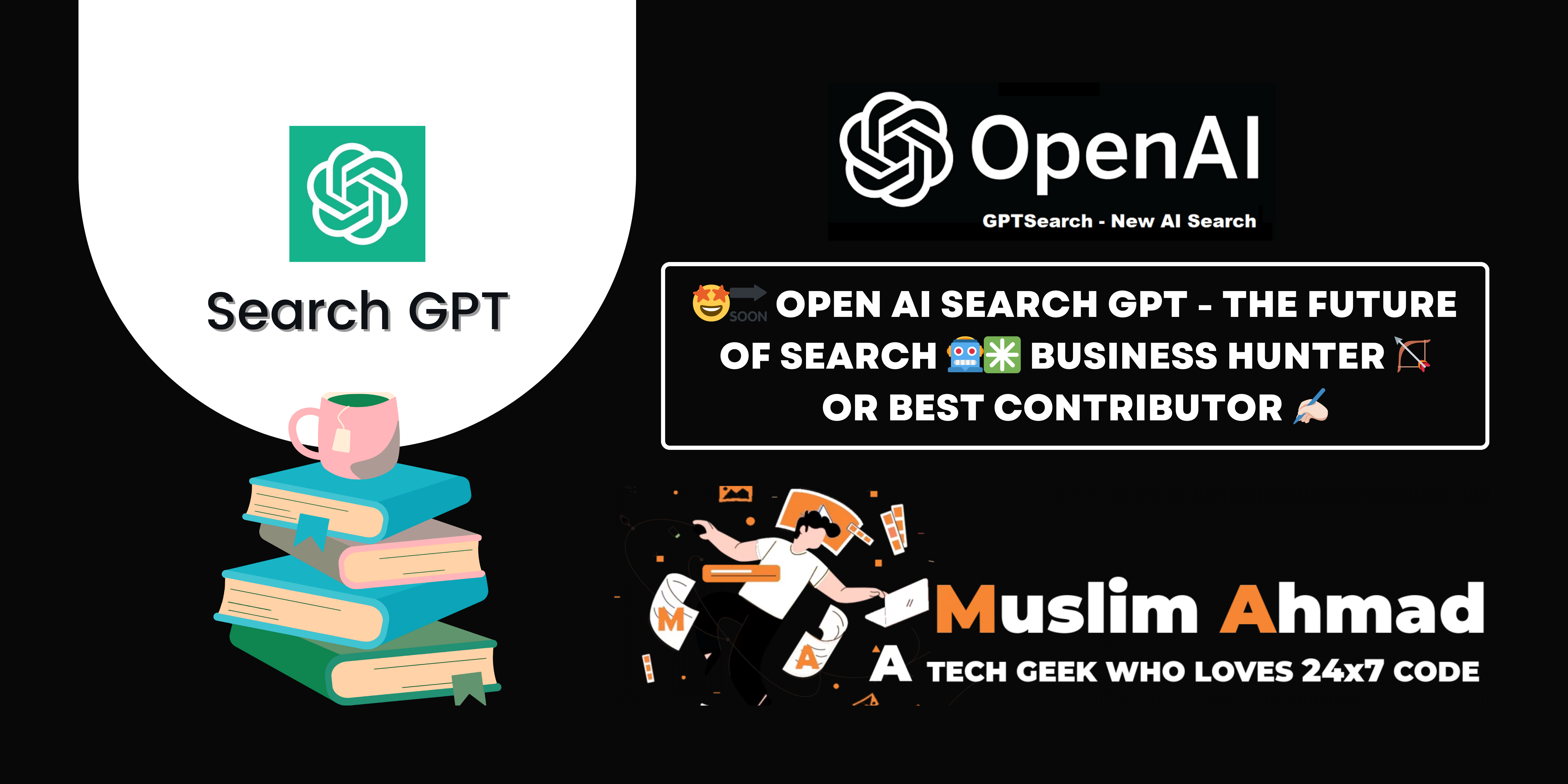In this blog, we will explore “🤩🔜 Open AI Search GPT – The Future of Search 🤖✳️ Business Hunter 🏹 or Best Contributor ✍🏻”. Here, this blog covers all topics like Understanding Search GPT, impact of Search GPT on Google, Top 10 Custom Models of Search GPT in the future?, Will Search GPT be a Business Hunter or the Best Contributor?, Search GPT Pricing Plans and many other things. Let’s dive in and check it out:
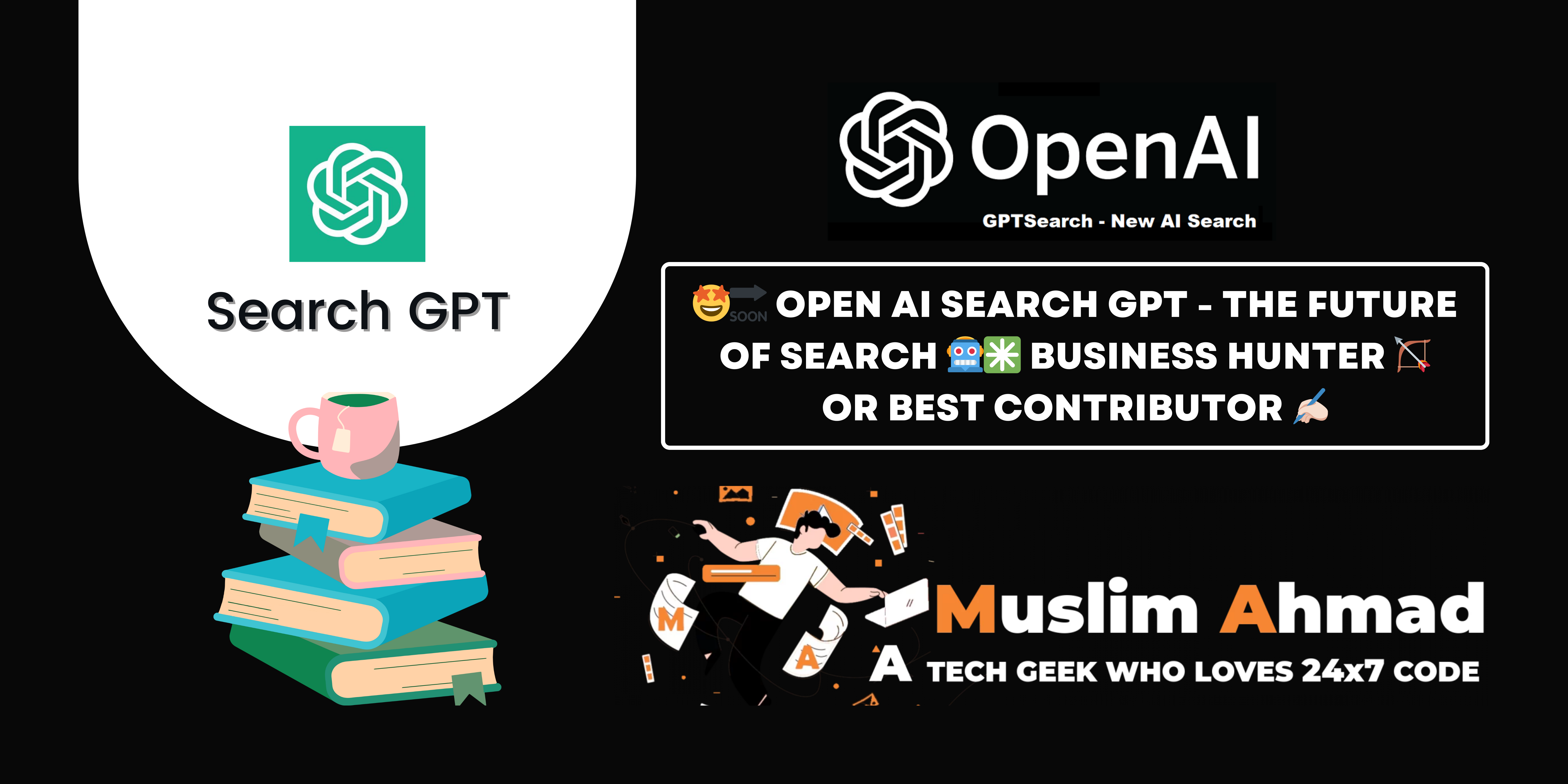
The Future of Search: Exploring the Capabilities and Potential of Search GPT
In a world where there’s no shortage of information and finding what we need is easier than ever, the way we search and get that info is always changing. Traditional search engines have done a great job for years, but as our questions get more complex, we need something even better. That’s where Search GPT comes in. This new tool uses cutting-edge technology to completely change how we search for and interact with information.
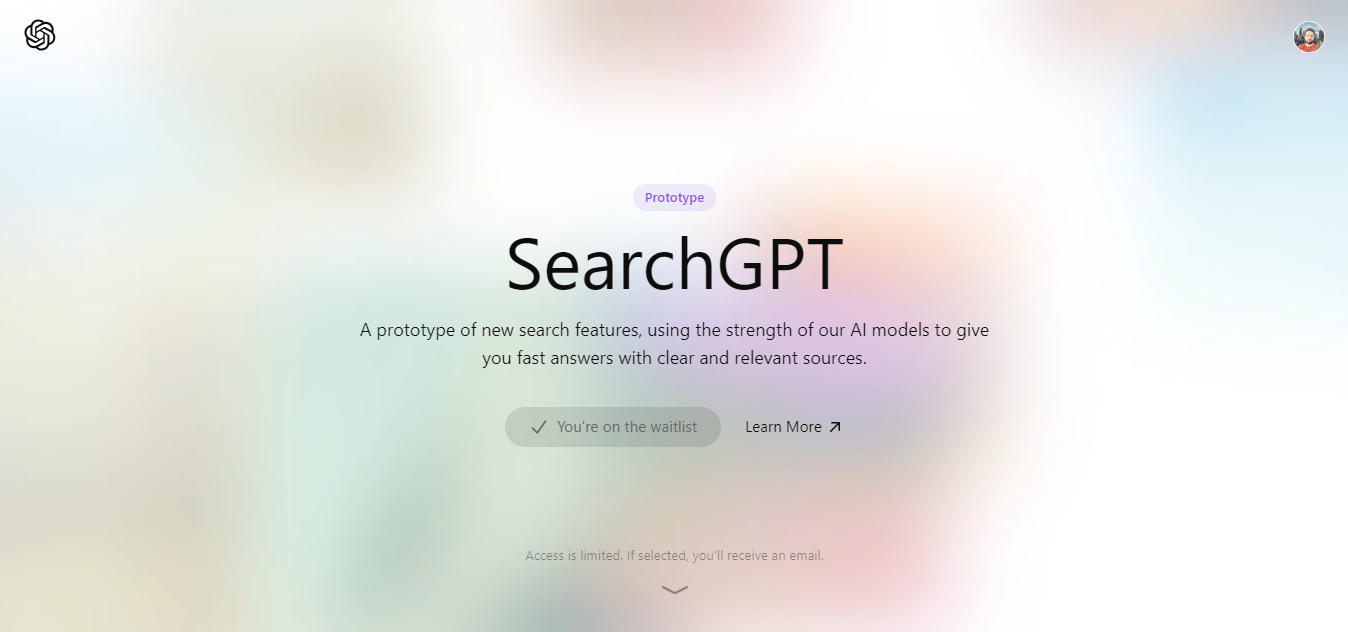
Understanding Open AI Search GPT
What is Search GPT?
Search GPT is a cutting-edge search system that uses a generative pre-trained transformer (GPT) model, similar to those created by OpenAI, to boost search capabilities. GPT models are great at understanding and generating text that feels natural, which helps them process and interpret language more effectively. By incorporating these models into search engines, we can get a deeper and more context-aware understanding of what users are looking for, leading to more accurate and relevant search results.
The Evolution of Search Technology
To really grasp why Search GPT is important, it helps to look at how search technology has evolved. Traditional search engines, like Google, use algorithms to index web pages and rank them based on factors like keywords, backlinks, and page relevance. While these methods work well, they struggle with understanding the context and intent behind more complex queries.
Search GPT tackles these limitations by using advanced natural language processing (NLP). Unlike traditional search engines that mainly focus on matching keywords, Search GPT understands the subtleties of language, grasps the meaning behind queries, and provides responses that better match what the user actually intends.
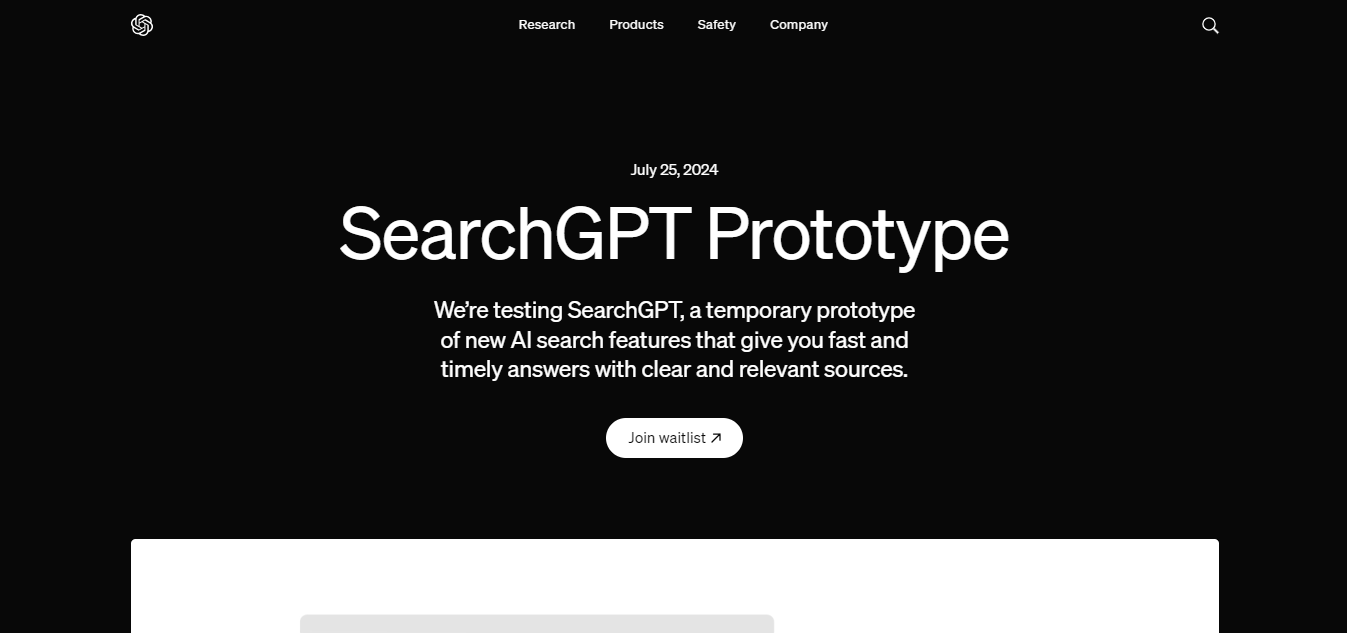
For more information on the Search GPT Prototype, you can visit this link: Search GPT Prototype.
You can join the waiting list from this link: Search GPT Waiting List and stay tuned on Open AI Youtube channel.
Is there an option for search from the web in Chat GPT 4 or GPT 4o models?
Yes, It’s already there in advanced models of Chat GPT. OpenAI’s integration of web browsing capabilities with Microsoft Bing in versions of GPT-4 and GPT-4o, such as the ChatGPT product with the browsing feature, enables the model to search the web in real-time. This enhances its ability to provide accurate and up-to-date responses by retrieving current information directly from the web. Check more details here.
What is the difference between Search GPT & Microsoft Bing Search on GPT 4 & GPT 4o?
The difference between web browsing capabilities in GPT-4 & GPT-4o models and a hypothetical “Search GPT” could involve several key aspects:
GPT-4 with Web Browsing:
- Purpose: Enhances GPT-4’s & GPT-4o’s ability to provide accurate and up-to-date responses by fetching real-time information from the web.
- Focus: Supplements the model’s general knowledge with current data within a conversational framework.
- Functionality: Uses web browsing to retrieve information to enhance responses to queries within a conversational context. The browsing capability is integrated into the conversational model.
- User Interface: Typically conversational, where the model interacts directly with users and responds to queries using information retrieved from the web.
- Integration: Web browsing is integrated within the conversational AI, serving as one feature among many to enhance conversational responses.
Search GPT:
- Purpose: If “Search GPT” were a distinct product, it might be specifically designed for conducting searches and providing search engine like results or advanced search functionalities.
- Focus: Aims at optimizing search results and improving search-related tasks rather than general conversational abilities.
- Functionality: Might offer specialized search features such as advanced ranking algorithms, more detailed search results, or sophisticated querying capabilities distinct from general conversation. It could focus on refining the search process itself.
- User Interface: If it were designed as a search tool, it might have a more traditional search engine interface with input fields for queries and a results page displaying search results.
- Integration: Might be a standalone tool or application with a focus on search capabilities, potentially integrating with other systems or services differently, such as through dedicated APIs or search algorithms.
If “Search GPT” becomes a specific product, its exact capabilities and differences are detailed in its official documentation or announcements. For now, GPT-4’s or GPT-4o’s web browsing is part of its broader conversational framework, enhancing its responses with up-to-date information.
What would be the impact of Search GPT on Google’s search engine and the entire Google company?
The advent of Search GPT and its integration into search technologies poses both opportunities and challenges for Google, the dominant player in the search engine market. Here’s a comprehensive look at the potential impacts on Google:
Enhanced Search Capabilities
Improved User Experience
- Contextual Understanding: Search GPT’s skill in grasping the context and subtleties of user queries can produce more relevant and accurate search results, boosting user satisfaction.
- Natural Language Queries: Users can interact with the search engine in a more conversational way, making it simpler for non-technical users to find the information they need.
Content Generation
- Rich Snippets and Summaries: Search GPT can create concise and informative snippets or summaries for complex topics right in the search results, so users don’t have to click through multiple pages to get the information they need.
- Automated Answers: For common queries, Search GPT can deliver direct answers, making information retrieval faster and more efficient.
Competitive Pressure
Innovation Acceleration
- Rapid Advancements: The integration of Open AI Chat & Search GPT into competitors like Microsoft Bing puts pressure on Google to keep innovating and improving its search algorithms and AI capabilities to stay ahead in the market.
- Investment in AI: Google might need to boost its investments in AI research and development to stay competitive with advancements in natural language processing and understanding.
Market Share Dynamics
- User Migration: If competitors using Search GPT offer significantly better search experiences, it could lead to a shift in user preferences and potentially impact Google’s market share.
- Diversification: Google might need to diversify its product offerings and focus on integrating AI more deeply across its ecosystem to keep its users.
Advertising and Revenue Models
Impact on Ad Revenue
- Direct Answers: With Search GPT providing more direct answers, users might spend less time browsing through multiple websites, which could lead to fewer ad impressions and clicks, potentially affecting Google’s ad revenue model.
- Enhanced Ad Targeting: On the flip side, Search GPT’s understanding of user intent can enhance ad targeting precision, potentially making ads more effective and valuable.
Business Strategy and Product Development
- Enhanced Services:
- Google Assistant: Integrating AI capabilities into Google Assistant can make it more powerful, offering better responses and handling more complex tasks.
- Content Tools: Google could enhance tools for content creation, using AI for SEO, marketing, and educational content.
- Competitive Differentiation:
- Unique Features: To stand out from competitors, Google might create unique features or services that go beyond what Search GPT offers, such as integrating additional AI forms or developing specialized search verticals.
- Partnerships and Acquisitions: Google could seek partnerships with AI firms or acquire startups with complementary technologies to strengthen its market position.
Ethical and Regulatory Considerations
- Bias and Fairness:
- Mitigating Bias: Since GPT can reflect biases from its training data, Google will need to invest in technology and processes to reduce these biases and ensure fair search results.
- Transparency: Google should be transparent about how it uses AI to build user trust, especially regarding data privacy and ethical AI use.
- Regulatory Compliance:
- Data Privacy: With growing concerns about data privacy, Google must ensure its use of AI technology complies with global data protection regulations.
- AI Ethics: Google will need to follow ethical guidelines for AI, addressing issues like misinformation, manipulation, and the responsible deployment of AI in search.
Will Search GPT be a business hunter or the best contributor?
The potential role of Search GPT in the business world can be seen in two main ways: as a “Business Hunter” or as the “Best Contributor”. Each role highlights different aspects of how Search GPT can enhance business operations and strategies.
Search GPT as a “Business Hunter”
- Role and Function:
- Opportunity Identification: Actively seeks out new business opportunities, market trends, and growth areas.
- Competitive Analysis: Analyzes competitors to identify their strengths, weaknesses, and provides actionable insights.
- Market Research: Conducts in-depth research to uncover emerging trends, consumer preferences, and industry shifts.
- Key Features:
- Proactive Insights: Provides real-time alerts and recommendations on new opportunities and market changes.
- Trend Analysis: Uses advanced analytics to predict future market trends and consumer behavior.
- Opportunity Alerts: Sends notifications about potential business opportunities, partnerships, and investment possibilities.
- Benefits:
- Growth: Helps businesses expand by identifying new markets and opportunities.
- Strategic Advantage: Provides a competitive edge by staying ahead of market trends and competitor strategies.
- Efficiency: Saves time and resources by automating market research and opportunity identification.
Search GPT as the “Best Contributor”
- Role and Function:
- Content Creation: Generates high-quality content for marketing, SEO, and customer engagement.
- Customer Support: Enhances customer support with AI-driven responses and personalized interactions.
- Operational Support: Assists with tasks like data analysis, report generation, and administrative work.
- Key Features:
- Content Generation: Creates articles, blog posts, social media content, and other marketing materials.
- Personalized Interactions: Provides tailored responses in customer support and marketing communications.
- Operational Efficiency: Automates routine tasks and improves workflow efficiency with AI-driven solutions.
- Benefits:
- Quality: Ensures high-quality content and customer interactions, boosting brand reputation.
- Productivity: Increases productivity by automating repetitive tasks and freeing up human resources for more strategic work.
- Consistency: Maintains consistent quality and tone in communications and content creation.
Comparison and Conclusion
- Business Hunter
- Focus: Primarily on external opportunities and market intelligence.
- Impact: Drives growth and strategic advantage by identifying and capitalizing on new opportunities.
- Suitability: Ideal for businesses aiming to expand, innovate, and stay ahead of market trends.
- Best Contributor
- Focus: Primarily on internal support and operational efficiency.
- Impact: Enhances productivity, quality, and customer engagement through AI-driven solutions.
- Suitability: Perfect for businesses looking to improve internal processes, content quality, and customer interactions.
Combined Approach
While each role has its unique advantages, combining the “Business Hunter” and “Best Contributor” capabilities of Search GPT can offer a well-rounded solution for businesses. This integrated approach helps businesses not only discover and act on new opportunities but also enhance their internal operations and customer engagement.
By leveraging both aspects of Search GPT, businesses can achieve a balanced strategy that fosters growth and efficiency, ensuring they remain competitive and adaptable in a constantly evolving market landscape.
What are the top 10 business models that could emerge with the help of Search GPT in the future?
Leveraging Search GPT can open up numerous innovative business models that take advantage of its advanced natural language processing and contextual understanding. Here are the top 10 business models that could thrive with Search GPT:
- Personalized Content Creation Platforms
- Overview: Platforms that use Search GPT to create personalized content, such as articles, blog posts, social media updates, and marketing materials.
- Business Model:
- Subscription-based: Monthly or annual fees for access to content generation tools.
- Freemium: Basic content creation features for free with premium options for advanced customization.
- Pay-per-use: Charges based on the volume or complexity of content generated.
- AI-Powered Customer Support Services
- Overview: Customer support platforms that integrate Search GPT to provide instant, accurate responses to inquiries, reducing the need for human intervention.
- Business Model:
- Software-as-a-Service (SaaS): Subscription fees for businesses to use the AI-powered support service.
- Usage-based: Pricing based on the number of customer interactions or queries handled.
- Enterprise Licensing: Custom pricing for large-scale implementations with dedicated support.
- Intelligent Search Engines for E-commerce
- Overview: Search engines designed for e-commerce sites, enhancing product discovery and recommendations through advanced natural language processing.
- Business Model:
- Commission-based: Percentage of sales generated through the search platform.
- Subscription-based: Monthly fees for access to the search engine and its features.
- Freemium: Basic search functionality for free, with premium features like personalized recommendations.
- Real-Time Market Research and Analytics
- Overview: Platforms that use Search GPT to provide real-time insights and analytics on market trends, consumer behavior, and competitive intelligence.
- Business Model:
- Subscription-based: Access to real-time data and analytics tools for a monthly or annual fee.
- Pay-per-report: One-time fees for specific market research reports or insights.
- Enterprise Solutions: Custom pricing for comprehensive analytics and integration with business systems.
- AI-Driven Educational Platforms
- Overview: Educational tools and platforms that use Search GPT to create personalized learning experiences, generate educational content, and provide instant tutoring.
- Business Model:
- Subscription-based: Monthly fees for access to personalized learning tools and content.
- Freemium: Basic educational resources for free, with premium access to advanced features.
- Pay-per-course: Charges for individual courses or learning modules.
- Automated Legal Research and Documentation
- Overview: Legal tech platforms that leverage Search GPT to conduct legal research, draft documents, and provide case law summaries.
- Business Model:
- Subscription-based: Access to legal research tools and document generation for a monthly fee.
- Pay-per-use: Charges based on the number of documents generated or searches performed.
- Enterprise Licensing: Custom pricing for law firms and corporate legal departments.
- AI-Powered Marketing Automation
- Overview: Marketing platforms that use Search GPT to automate content creation, social media management, and customer engagement strategies.
- Business Model:
- SaaS: Monthly fees for access to marketing automation tools.
- Freemium: Basic marketing features for free, with premium automation options.
- Pay-per-campaign: Charges based on the number of marketing campaigns or interactions managed.
- Personalized Healthcare Information and Support
- Overview: Healthcare platforms that use Search GPT to provide personalized medical information, symptom checkers, and virtual health assistants.
- Business Model:
- Subscription-based: Monthly fees for access to personalized healthcare tools and information.
- Freemium: Basic health information for free, with premium access to personalized advice and support.
- Pay-per-consultation: Charges for virtual health consultations or detailed medical reports.
- Advanced Recruitment and Talent Management
- Overview: Recruitment platforms that use Search GPT to match candidates with job openings, generate job descriptions, and provide personalized career advice.
- Business Model:
- Subscription-based: Monthly fees for access to recruitment tools and talent management features.
- Pay-per-hire: Charges based on successful placements or candidate matches.
- Freemium: Basic recruitment tools for free, with premium features for advanced matching and analytics.
- AI-Enhanced Personal Finance and Investment Advisory
- Overview: Financial platforms that use Search GPT to offer personalized investment advice, financial planning, and real-time market analysis.
- Business Model:
- Subscription-based: Access to financial planning and investment advisory tools for a monthly fee.
- Freemium: Basic financial tools for free, with premium access to personalized advice and advanced analytics.
- Pay-per-advisory: Charges for one-time financial consultations or detailed investment reports.
What would be the pricing plans for Search GPT? Would it be free or paid?
The pricing plans for Search GPT are likely to vary based on several factors, including use cases, access levels, and integration needs. Here’s a breakdown of potential pricing models:
Freemium Model
- Free Tier
- Basic Access: Users get fundamental search features with a limited number of queries per month.
- Limited Features: Basic natural language processing and contextual understanding, without advanced capabilities like personalized results or content generation.
- Premium Tiers
- Subscription Plans: Monthly or annual plans offering enhanced features and higher query limits.
- Feature-Based Pricing: Various tiers with different features, such as personalized search, advanced content generation, real-time data integration, and priority support.
Usage-Based Pricing
- Pay-as-You-Go
- Query-Based Charges: Users pay based on the number of queries or searches performed, with rates varying by query complexity.
- Scalability: Allows users to adjust usage according to their needs, making it cost-effective for both small businesses and large enterprises.
API Access
- Developer Plans
- Pricing for API Access: Allows developers to integrate Search GPT into their applications and services.
- Tiered Pricing: Different tiers based on API calls, data processing requirements, and features like real-time updates or advanced analytics.
Enterprise Solutions
- Custom Pricing
- Tailored Plans: Custom pricing for large enterprises with extensive customization, dedicated support, and integration with existing systems.
- Volume Discounts: Discounts based on query volume or scale of deployment, making it economical for large implementations.
- Enhanced Support
- Dedicated Account Managers: Personalized support and account management for enterprise clients.
- Service Level Agreements (SLAs): Guaranteed uptime and performance metrics for reliability and trust in critical business operations.
Potential Free Access Scenarios
- Educational and Research Institutions
- Free Access for Education: Special plans for educational institutions, offering advanced search capabilities for free or at a discounted rate.
- Research Grants: Grants or sponsorships for research projects utilizing Search GPT, promoting academic exploration.
- Non-Profit Organizations
- Subsidized Access: Reduced or free access for non-profits, enabling use of advanced search capabilities for social good without financial burden.
Value-Added Services
- Add-Ons
- Additional Features: Optional add-ons like enhanced data analytics, advanced machine learning models, or integration with other AI services.
- Customization Options: Tailored solutions for specific industries or use cases, providing additional value and functionality.
- Training and Support
- Training Programs: Paid programs including workshops, webinars, and certification courses to help users and developers maximize their use of Search GPT.
- Priority Support: Premium support options with faster response times and dedicated personnel for resolving issues and optimizing performance.
Here are some key features of a Search GPT system:
- Contextual Understanding: Search GPT comprehends the context of a query, delivering more relevant and precise search results.
- Natural Language Processing: It interprets and processes natural language queries, allowing users to search using everyday language.
- Content Generation: Beyond retrieving information, Search GPT can generate informative responses, summaries, or explanations.
- Personalization: It learns from user interactions to offer personalized search experiences, continuously improving based on user behavior and preferences.
- Enhanced Query Interpretation: Capable of handling complex queries, synonyms, and varied phrasings, Search GPT understands user intent more effectively than traditional search algorithms.
Overall, Search GPT blends the strengths of advanced language models with search technology to deliver a more intuitive and powerful search experience.
Conclusion
Search GPT represents a major leap forward in the field of information retrieval. By harnessing the capabilities of generative pre-trained transformers, it offers a more nuanced, context-aware, and personalized search experience. Its potential applications are extensive, spanning healthcare, education, customer support, and legal research. However, to fully harness this technology, it’s crucial to address challenges related to data privacy, bias, computational resources, and accuracy.
Looking ahead, Search GPT’s evolution is set to transform how we search for and interact with information, making it more intuitive, efficient, and accessible. Its integration into search technologies presents both opportunities and challenges for Google. By enhancing search capabilities, improving user experiences, and enabling more precise ad targeting. The advent of Search GPT will likely push Google to redefine what’s possible with search technology, leading to more advanced and effective search experiences for users.
The business models leveraging Search GPT highlight its potential to revolutionize various industries through personalized, efficient, and intelligent solutions. Companies that embrace and innovate with Search GPT technology will be well-positioned to lead in the future digital economy.
Pricing plans for Search GPT are expected to be Google and adaptable, catering to a broad spectrum of users—from individuals and small businesses to large enterprises and specialized industries. A freemium model, combined with usage-based pricing and custom enterprise solutions, can provide accessible entry points while meeting the needs of more complex use cases. Additionally, offering free or subsidized access to educational and non-profit organizations can promote widespread adoption and innovation. As the technology evolves, pricing strategies will need to adjust to balance accessibility and sustainability.
As we eagerly await the launch of Search GPT, the excitement builds around the potential to revolutionize information retrieval and transform user experiences across diverse fields.
Thanks for reading this blog, if you haven’t subscribed to my blog yet, follow the instructions in the image below & stay tuned:
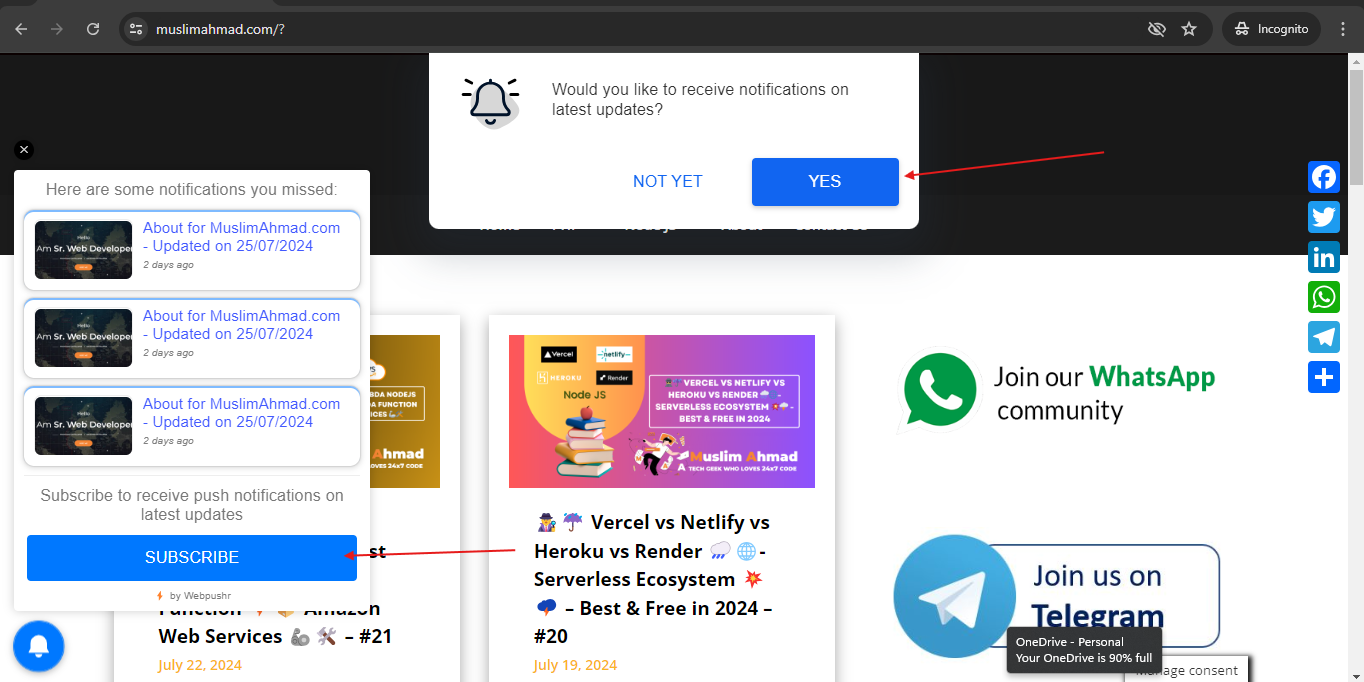
Check out recent blogs:
🕵️⚡Exploring Serverless Framework AWS Lambda λ – Cloud DevOps Framework 😶🌫⛈️ – Free to Paid – #22
👨🏻💻⚡ Serverless AWS Lambda NodeJS – A Best Guide to λ Lambda Function 🌩️📦 Amazon Web Services 🦾🛠️ – #21
🕵️☔ Vercel vs Netlify vs Heroku vs Render 🌧️🌐- Serverless Ecosystem 💥🌩️ – Best & Free in 2024 – #20
🤔 Will AI eat jobs 🤤 v0.dev Vercel Revolution – Free AI Tool 😭⍩⃝ – #19
👨🏻💻 How to use v0.dev Vercel – Free Revolutionizing AI Tool 🎉🤩 – #18
Revolutionary Event – Vercel Ship 𓊝 Recap – #17
New Trick – Organizing Prisma Models with the MERN Stack – Prisma #16

